The Best (Castle) a Man Can Get
East Haddam & Lyme (Google Maps Location)
May 31, 2009
I’ve since visited Gillette Castle many times, for many different reasons. In fact, there are several other CTMQ pages about the state park, often with much better pictures.
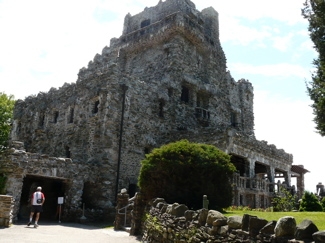
Aha! A rarity on CTMQ: A museum I’d visited before the existence of this blog! Also, my mom and dad joined Hoang, Damian and me for this one – and it all turned out well. But writing this one up is anything but elementary, my dear Watson…
This place has it all: History, beauty, architecture, craftsmanship, scenic views, scenic drives, politics, entertainment, hiking, humor… On and on. I was happy to bring my parents here, as I knew they’d both get enjoyment out of different aspects of Gillette Castle. (Of course, I also took them to the wonderful but decidedly smaller and more esoteric Shad Museum beforehand, so it all works out.
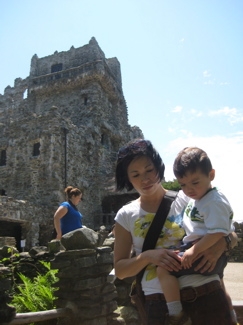
No matter which way you approach the state park, it’s a beautiful drive. You will either twist and turn through the woods on the eastern side of the Connecticut River or better yet, take the Chester-Hadlyme Ferry over from western side (weather/season depending). It’s a very short but very pretty ferry ride. Here is a random picture of me and Hoang at the western ferry slip with Gillette Castle across the river up on the hill:
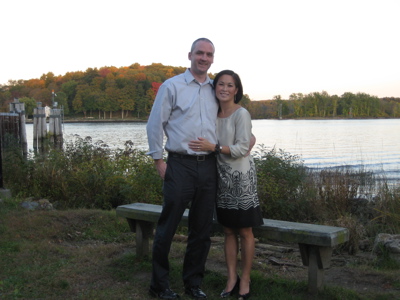
Yeah, she’s hot. I know it. Huh? Oh, I just noticed that the castle was a little to the left of that shot. Here:
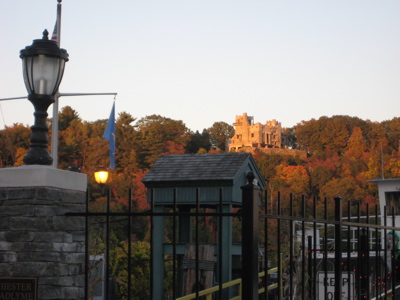
The park and castle/museum are located up on a hill overlooking the river. But why? And who was Gillette?
Atop the most southerly hill in a chain known as the Seven Sisters, William Hooker Gillette, noted actor, director, and playwright, built this one hundred and eighty-four acre estate, the Seventh Sister. The focal point of his effort was a twenty four room mansion reminiscent of a medieval castle.
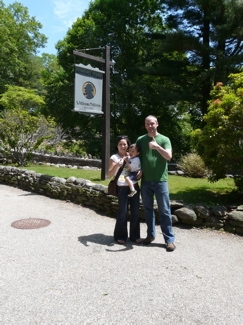
Wait – before you decide that Gillette was an egotistical nut, check out what was in his will in the following paragraph…
Purchased by the State of Connecticut in 1943 from the executors of Mr. Gillette’s will, Gillette Castle and the adjoining property with its fine woodlands, trails, and vistas are now administered for the enjoyment of present and future generations. This apparently would have pleased Gillette, since his will gave specific directions to see that the property did not fall into the hands “of some blithering saphead who has no conception of where he is or with what surrounded.” This statement also points out the value Gillette placed upon his estate and the apprehension he felt about its disposition.
Awesome. Hoang and I are going to be doing our official wills soon, and we agree that we need to include some funny stuff in them.

We parked and first went into the visitor center building. Apparently built in order to preserve the former residence, this building is a tasteful structure and far enough away from the castle so as not to compete with it; a job well done – by the state! The center opened in May 2003; it features a small auditorium, gift shop, exhibit area, and special-events plaza.

We walked the quarter mile or so to the castle and stopped for a moment at what was once Gillette’s train station. He called it “Grand Central.”
The expansive grounds were also touched by his imagination. He had a fascination with railroads and operated a miniature train with some three miles of track laid throughout the woodland and granite ledges. Indeed, he delighted in playing the “engineer” of his steam and electric engines for distinguished guests from around the world. The Seventh Sister Short-Line railway once had trestles, bridges, a tunnel, and a Grand Central Station — adorned with two sculptures of cats, among the 60 cat images in and around the estate.
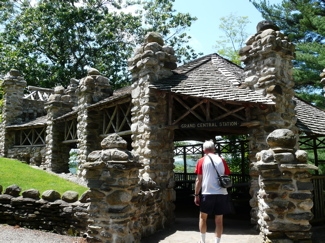
In fact, some of the track was purchased by Lake Compounce in Bristol, Connecticut and is in use to transport guests around the lake. The remaining track was pulled up and converted into walking trails. The trails often follow, over trestle and through tunnel, the actor’s three mile long narrow gauge railroad. Gillette’s own walking paths were constructed with near-vertical steps, stone-arch bridges, and wooded trestles spanning up to forty feet. Other outdoor attractions include a vegetable cellar and Gillette’s goldfish pond.
This whole area north and around the house is stunning. From the castle’s garden one can see the Connecticut River and all the way out to the Long Island Sound.
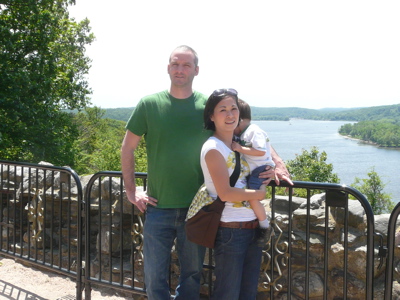
Now you’re thinking that this “noted actor, director, and playwright” was a kook. Well, maybe, but an interesting and creative one to be sure. And he wasn’t a slouch either.
Gillette designed the castle and most of its contents personally, periodically checking every phase of their construction. Built of local fieldstone supported by a steel framework, it took twenty men five years (1914-1919), to complete the main structure. Gillette began his semi-retirement in his new home; and in the following years, he supervised the many thousands of refinements created by local craftsmen.

The 24-room mansion is reminiscent of a medieval fortress on the Rhine River, and its 184-acre natural surroundings are laced with pathways ideal for an easy walk with family and friends. The Castle Building is 200 feet above the river and is made of local granite fieldstone covering steel beams.
Let’s go inside already – I love this place. It’s unique and quirky without being annoying or stultifying. It’s really beautiful and homey inside despite it’s somewhat menacing exterior. As we entered, a guide explained to us that the informal pathway through the house was one-way, and once upstairs there was no coming back down.
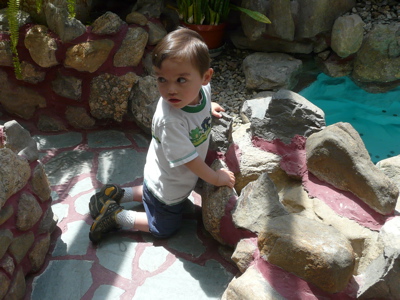
She also kindly noted that we weren’t to touch anything and to generally be careful. Fair warning – especially since we had Damian with us. We promised to keep him in line and went on our way.
Not more than 10 seconds later, my 66-year-old father with perfectly functioning ears and a Masters in chemical engineering as well as an MBA for the heck of it, decided it would be a good idea to flip a light switch. Sure, they looked neat, but what the heck man? The lady who just got finished telling us not to do it gave our group a menacing look – and I called out my pops without hesitation.
This was gonna be fun.
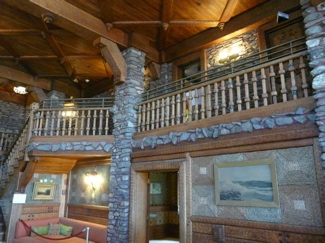
Gillette was born in Hartford, Connecticut, in 1853, the son of former U.S. Senator Francis Gillette and his wife Elizabeth Daggett Hooker Gillette, a descendent of Thomas Hooker, the founder of Hartford. As a child, Gillette was captivated with the stage and acting pursuits, an interest that his parents did not encourage.
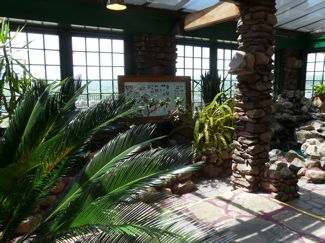
At age thirteen, he reputedly had built a small stage and amused himself by frequently giving puppet shows for his friends – something Howard Stern used to do as well. At age twenty, he left home to follow his chosen career; but success was slow in developing. He attended classes at numerous colleges including Trinity, Yale, Harvard, Massachusetts Institute of Technology, and College of the City of New York, but never received a degree.
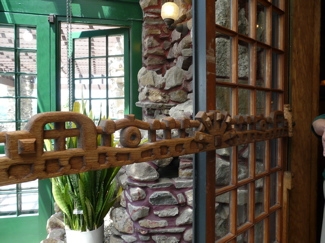
His first recognition as an actor was attained when the lead became ill in “Broken Hearts” at the Globe Theater in Boston, and Gillette’s stand-in performance was well received. This led to other and better roles for Gillette. He is most famous for his portrayal of “Sherlock Holmes”.
Besides his activities as an actor and playwright, Gillette is known to have written two novels, invented many trick stage props and lighting techniques, and often produced and directed the plays in which he appeared. After his semi-retirement in 1910, Gillette was welcomed by theatergoers countless times during his four revival tours. His last performance was at the Bushnell in Hartford in 1936, the year before his death.
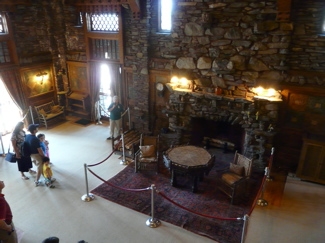
Damian was perfectly content for a while with the little indoor waterfall and pond while I listened to the guide talk about the house and all its eccentricities. Nooks and Crannies, Secret Passages, Hidden Compartments, Cunning Locks, Exotic Wood and Stone-work, and the many sidelights of a clever and theatrical personality…all are on view at the castle.
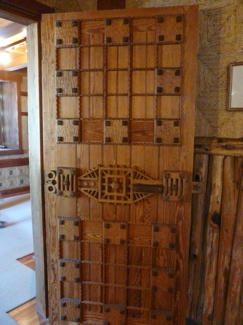
The woodwork within the castle is hand-hewn southern white oak. Of the forty-seven doors within the structure, there are no two exactly the same. And each door has a handsome external latch intricately carved of wood. Even the Castle’s furnishings are indications of Gillette’s inspirations. The built-in couches, a movable table on tracks, and light switches of carved wood all point to his creative genius.
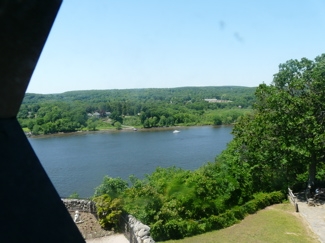
This place is great – my dad was enthralled with the woodwork and masonry, my mom couldn’t get enough of the entertaining quirks of Gillette’s personality, I was fascinated by the fact that the DEP runs this place and Hoang… well, now Hoang was preoccupied with following Damian around the joint. We aren’t the only ones with an interest in the castle – some 100,000 people take the DEEP-guided tours of the building each year. I’m sure another 50-thousand come here just to picnic as well.
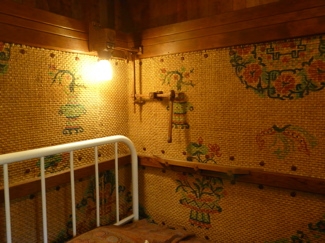
There were guides in most rooms as we wandered about, explaining the random unique things along the way. This would be a very, very fun place to live.
I noted some details along the way… And so did Damian. In fact, he tested out a couple beds when no one was looking, much to Hoang’s horror/delight. That’s our boy.
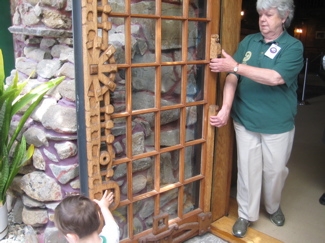
After finishing up downstairs, we went up to the 2nd floor and passed the “secret passage.” This door allowed Gillette to “magically” and theatrically appear at the top of the steps overlooking the great hall whenever he felt his guests deserved that flourish. Alternatively, he could escape through this door to get out (or in) the house to avoid jerks in the great hall.
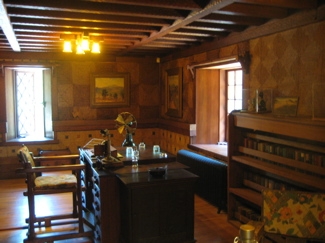
Once upstairs, we peered into a few bedrooms. The Blue Bedroom was where overnighters stayed, including his acting friends like a young Helen Hayes. The Green Bedroom was used by Gillette’s niece, with whom he was very close. Like the other bedrooms, the walls are enhanced by the natural fibers of the grass matting in rich colors of beige, green and tan. Gillette used decorative wood paneling, special lighting and ornately carved doors in this room – as you’d expect.
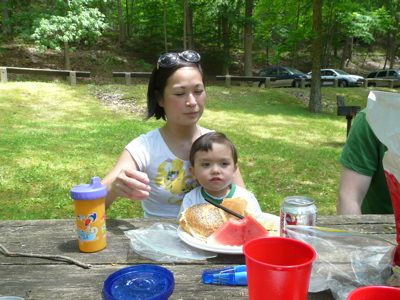
Gillette’s own bedroom was much smaller than you’d expect. But while it was cozy, it had everything he needed. The bureau had 17 drawers in it, all of which sort of telescoped out like a fan. He had a lever system that would turn off all the lights so he could read in bed. And Damian reports that his bed was pretty comfortable too.
I’ve saved the coolest detail of the house for last… Gillette not only had those uniquely carved door handles and locks all over the house, but he also enjoyed a bit of innocent spying and fooling around. He used mirrors to check on visitors entering the Great Hall. Looking at the mirrors above the French doors at the far end of the Great Hall, he could decide to stay in his room or make a dramatic entrance.
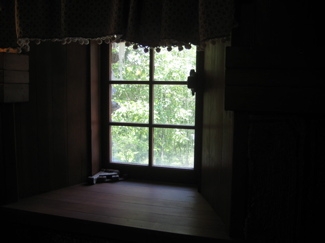
He also observed guests at the liquor cabinet with the mirrors above the French doors to the right of the fire place. Like other pieces in the castle, the liquor cabinet has an intricate and tricky opening device. After watching guests fumble with the latch, Gillette would reveal the secret procedure.
I love this guy.
I guess you can build a whimsical castle when you’re rich. William Gillette was a stage and screen “superstar” who created the role of master detective Sherlock Holmes…he starred in thousands of productions; wrote 13 original plays and dozens of adaptations; had 17 cats; had a yacht named Aunt Polly; had a caretaker, Osaki, who lived in a house which still stands on the riverbank.
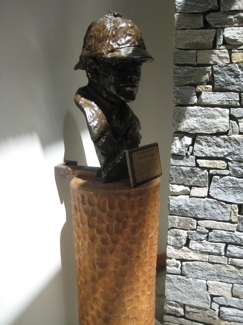
Once done with the castle, we adjourned to one of the picnic groves within the state park and enjoyed a good old-fashioned picnic like I remember having as a kid. It was pretty nice, I must admit.
I will totally revisit this place from time to time… [2018 Update… I have!]
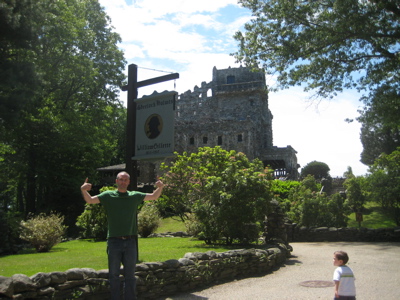
Damian observes his cool father…
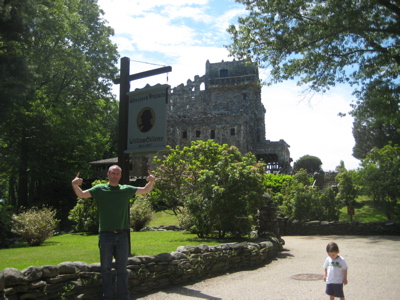
And hangs his head in shame.
DEEP: Gillette Castle State Park
CTMQ: Several other Gillette Castle pages!

 Jenny says
Jenny says
March 10, 2010 at 9:00 amWhat will be the name of your family band? Your comment about that picture made me LMAO! Ahh Woody, you’re the best!
 Chris says
Chris says
March 12, 2010 at 7:25 amAnother great write up. we are one of the “50,000” or so that just go to picnic and also feed the gold fish at the pond that you pass as you drive in.
Did you walk/hike any of the trails on the property? or the old railroad?
Also, I was surprised not to read about a visit to the 3rd floor art gallery. some great pieces in there.
 Steve says
Steve says
March 12, 2010 at 8:26 amI know. I certainly should have mentioned the art gallery – by then Damian was all done with the castle and I was kind of hurried through it, but you’re right; there are some very nice pieces up there. Especially if you like cats!
We didn’t get a chance to hike around unfortunately. But I’ll get back there someday and walk around and post a separate report… Just to see if there really is a tunnel there still!